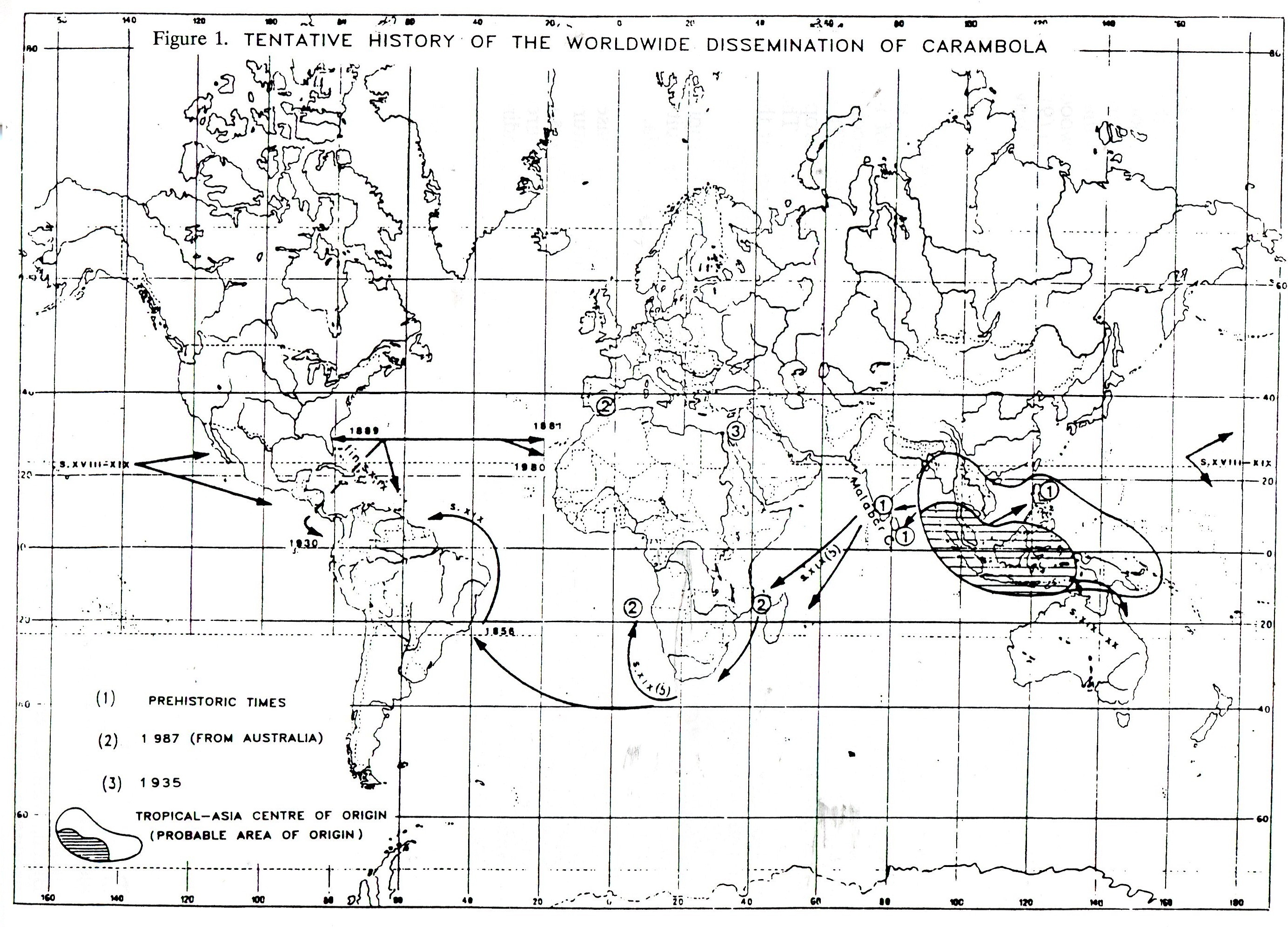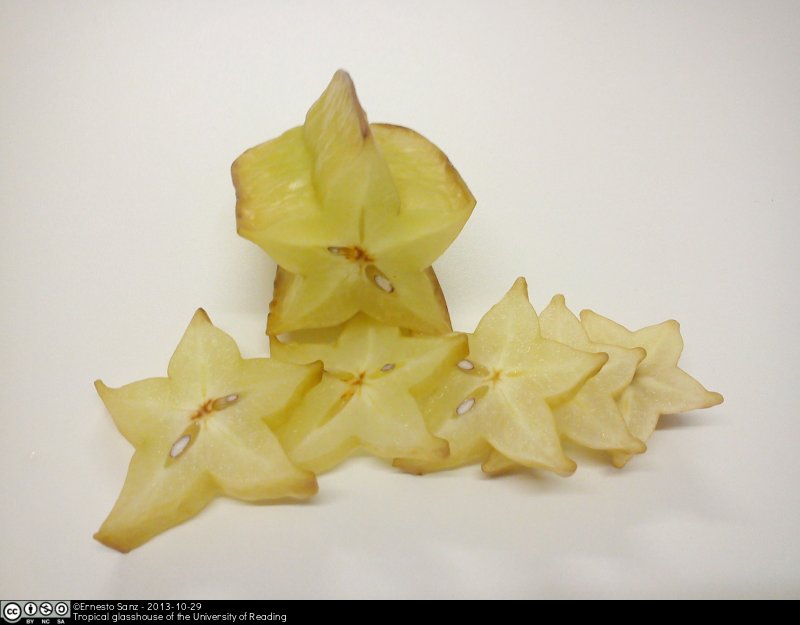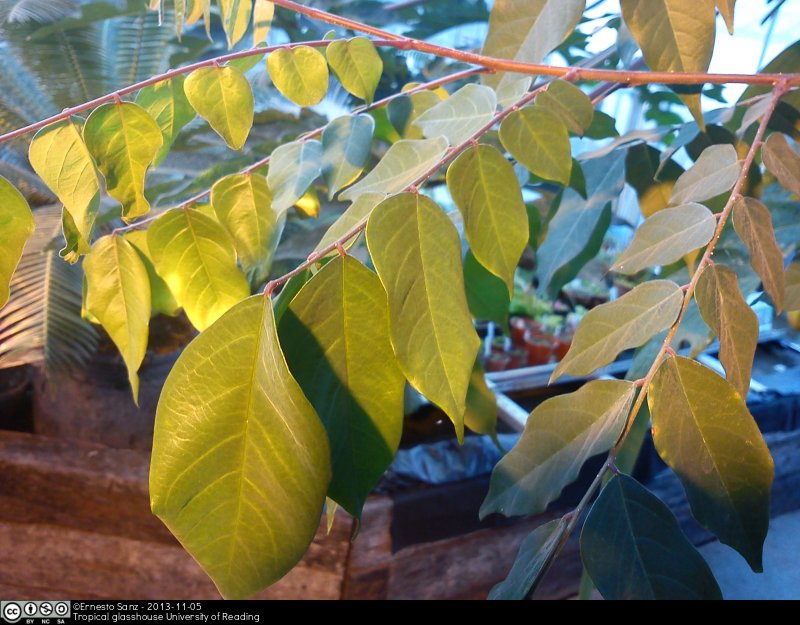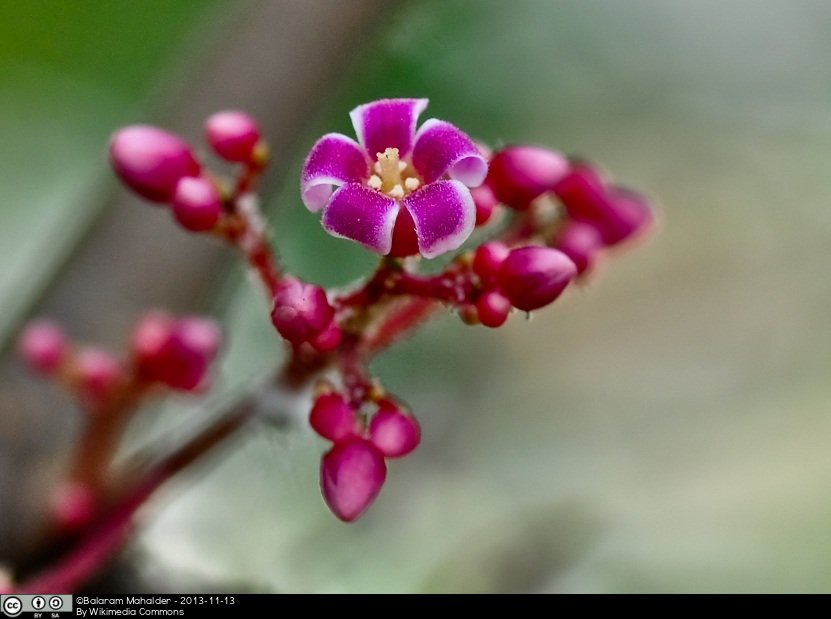Averrhoa carambola L., the starfruit is one of those strange and unique products that come from the east of Asia, with its funny shape and curious flavours, which you can love or hate, it is beggining to appear broadly in the European and North American markets. It can be used to decorate a dessert or to make a salad a new experience of flavours. In addition it is increadibly widely used in traditional medicine and can decorate your garden or help you to take the rust off!!
In this post I am going to explain different aspects about the starfruit, although I am going to try to explain it in an understandable way for everybody, a little bit of botanical knowledge will be very helpful.
Its common name comes from the five prominent ridges of its fruits, which produce a star-like shape when you cut it transversely (see fig 1 & 2). That is also the reason for their usage in salads or desserts as a decoration and also as a fresh ingredient with a slightly sour taste.
Averrhoa is one of the two genera with tree-like species of the family Oxalidaceae in addition to Sarcotheca (the other tree-like genus, with 3 spp.), Oxalis (c. 800 spp.), Biophytum (70 spp.) and Dapania (3 spp.), which can be herbs or shrubs. The leaves are alternate, sometimes simple but usually pinnately or palmately compound. They often have underground storage bulbs, tubers or fleshy roots. Averrhoa is pretty unique genus in this family, in fact, Hutchinson in 1959 split the genus into its own family, the Averrhoaceae, although the majority of botanists consider Averrhoa as part of the family Oxalidaceae (Heywood et al, 2007; Galán Saúco & Menini, 1993; Stevens, 2013).
The two Averrhoa species are: A. carambola and A. bilimbi L.. Both are small evergreen trees with odd-pinnate leaves, fleshy fruits (see fig. 1 & 2) and an economic interest for their fruits, although the fruit appearance, fruiting and flavor are markedly different and A. carambola is more widely used (Paul & Duarte, 2012). You can differentiate these two species by their leaves: A. carambola has leaves along branches with hairy leaflets (see fig. 3) and A. bilimbi has the leaves aggregated in the apex of branches with glabrous leaflets according to the Flora of China (Wu & Rave, 1994). The leaflets of starfruit have in the base a special structure called a pulvinus that allows the plant to move the leaflets (see video). The leaflets are touch sensitive and when the leaves are shaken by a windy storm or a potential herbivore, the leaflets take a vertical orientation to avoid damage.
The flowers of starfruit are disposed in a loose axillary or cauliflorous (developing on the trunk) panicle and have five pink sepals surrounding five purple petals, 10 stamens of which 5 are adjacent to petals and the rest are reduced to staminoids and 4 or 5 free styles develop from the ovary. The heterostyly (morphological variation of the position of the stamens and styles) is characteristic of this species, some cultivars have short-stamen and long-style (see fig. 4) and other have long-stamen and short-style (Paul & Duarte, 2012).
The heterostyly is a mechanism to avoid self-pollination, a mans of maintaining genetic variability. Consequently, the starfruit needs help to be pollinated; this responsibility rests in the insects and occasionally the wind. (Heard, 1999; Darshana, 1979).
Nomenclature:
Its formal scientific name is Averrhoa carambola L. Sp. Pl. 1: 428. 1753. Since it was described by Carolus Linnaeus, it does not have a large list of synonyms, because its taxonomical status was relatively clear:
≡ Averrhoa acutangula Stokes
≡ Averrhoa pentandra Blanco
≡ Connaropsis philippica Villar
≡ Sarcotheca philippica (Villar) Hallier f.
However, there is a big variety of common names due to his presence in all the tropical areas:
Chinese: Yang tao (阳桃)
Creole: Blinblin long, karambola, kònichon peyi or ziblinn long
English: Carambola, Starfruit or Chinese gooseberry
Filipino: Balimbing
Finnish: Karambola
French: Blinblin longue, carambolier or cornichon du pays
Hindi: Karmal (करमल)
Indonesian: Belimbing manis
German: Karambole or Sternfrucht
Lao (Sino-Tibetan): Füang
Malayan: Tamarattai
Pakistan: Kamrak or kamranga
Spanish: Carambola, fruta estrella, tamarindo chino or tamarindu culi
Swahili: Mbirimbi wa kizungu
Thai: Ma fueang (มะเฟือง)
Vietnamese: Khê
Urdu: Kamrakh (कमरख़)
References: (Wu & Rave, 1994; Explorer, 2013; Worldagrofrestry, 2013)
Distribution and ecology
The starfruit is not found in the wild, it can only be found in plantations and in naturalized populations. Such a situation makes it extremely hard to research its original geographical area. It is generally considered to be native to Indochina, although it also has been indicated to be originally from Malaysia, Indonesia or Moluccan Archipelago and some authors have mention Sri Lanka or India as possible areas of origin, but is commonly accepted that this species is native to the Indochinese-Indonesian centre (see fig. 5) (Galán Saúco & Menini, 1993).

Figure 5: Tentative distribution map of Averrhoa carambola . The shaded area is the potential zone of origin, and the lines are the routes of expansion of the starfruit according with the legend in the map. Source: Food and agriculture Organization of the United Nations, 1992, Galán Saúco & Menini, Carambola cultivation. Reproduced with permission.
Carambola reached neighbouring areas such as the Philippines as long ago as prehistoric times, and there is even a Sanskrit name (Karmara) for this species in India, which points to the antiquity of the presence of this species in this part of the world. However the dissemination of this plant to other places of the world has been very recent. The presence of Carambola in America dates from the 18th century and it was known to be growing in the botanical garden of Rio de Janeiro in 1856, 20 years later the plant was reported to be growing in Florida and in Trinidad and Tobago, and it was successively introduced throughout the entire Caribbean area and later in the whole of tropical America. At the end of the 19th century the species reached the African continent and then extended to Europe, through the South of Spain, Málaga (see fig. 5) (Galán Saúco & Menini, 1993).
Nowadays it is mainly cultivated where it is thought to be native (Indonesia, and southeast of Asia), China, Thailand, Brazil, Florida (USA), plus some areas of Australia (Queensland, Darwin and New South Wales), Israel, Guyana, Surinam and Trinidad-Tobago. Taiwan is the main producer (Galán Saúco & Menini, 1993).
Ecology and cultivation
The starfruit has a great adaptative potential and that is why it has had a great commercial success. It is cultivated not only in all the tropical areas but also in warm subtropical zones of the world, showing good resistance to occasionally freezing periods in Florida. Nonetheless it is a tropical species and has its maximum production in the range between 22 ºC and 33ºC with a rainfall range from 1,500 to 3,000 mm/annum but is able to grow in dry areas of the north of India (Galán Saúco & Menini, 1993; Crane, 1994).
Although much research is needed, it looks like the photoperiod and change in day/night temperature does not make a big difference to the flowering time. It is, however the water stress which apparently has a major influence in the production of flowers, and the fruits (Galán Saúco & Menini, 1993).
Once the plants is mature, it produces flowers at intervals of approximately 3 or 4 months, having flowers 3 times per year, and it takes 3-4 weeks until the fruit is ready for collecting. To make the collection easier the buds of the plants higher than 1 m are usually removed, but it can reach 2.5 m in more extensive cultivation (Paul & Duarte, 2012).
There had not been any research in the varieties of Carambola until the last decades. Traditionally there were two big groups of cultivars: sweets and tart. But in the recent years a more clear system of cultivars have been developed, although this still needs more research since the synonymy is common between some cultivars of the starfruit. The cultivars (see table 1) were selected by characteristics such as the taste of the fruit, skin thickness, adaptability to new areas and resistance to pest. (Galán Saúco & Menini, 1993; Crane, 1994).
|
Cultivar |
Origin |
Taste |
Recommended use |
| Arkin | Florida | Sweet | House & commercial |
| Dah Pon | Taiwan | Sweet | Not recommended |
| Demak | Indonesia | Sweet | House |
| Golden Star | Florida | Tart | House & commercial |
| Sri Kembangan | Malaysia | Sweet | Not recommended |
| Thayer | Florida | Tart | Home |
Table 1: Some of the main cultivars established in commercial areas. The cultivar Arkin is the most used cultivar (Galán Saúco & Menini, 1993; Crane,1994).
Uses
The carambola has a lot of different usages in the countries where it is cultivated, although is much more used in the South and East of Asia than in South America.
Food uses
As we have already said, there are two main types of starfruits, the sweet and tart ones. The first one is perfect to fresh consumption, since if you cook it, loosed its flavour and texture. The tart type is only for cooking. The sweet varieties is eaten row or in a salad in Florida and Southeast Asia and is mixed with avocado and seafood in Thailand. In Malaya they often stew it with sugar and cloves, alone or combined with apples; and in China they cook carambolas with fish. In mainland China and Taiwan they prepare the carambolas as a candy, and export it, slicing and canning it in syrup. Similar to Chinese recipe is the Australian one, in Queensland the leave it one night in honey and the fry it slightly and make jam or other preserves (Galán Saúco & Menini, 1993).
It is cooked in more different ways in other countries, for example in Hawaii and Philipines they make juice with the fruits and in Java they use the acid flowers as a component of salads (Galán Saúco & Menini, 1993).
Medical uses
The roots, the leaves and the fruits of the Starfruit have been widely used in medical treatment, especially in Asia:
In Philippines the leaves and shoots are used as a remedy for chickenpox, intestinal parasites and headaches. The fruit is mentioned as a laxative, antiscorbutic, febrifuge and as antidysenteric. It also stimulates the appetite. The seeds in infusions or tinctures in high doses can be used as abortive; they also have narcotic and emetic properties that are used to alleviate asthma and various colics (Galán Saúco & Menini, 1993).
In China the fruit is recommended as a febrifuge and against polydipsia (excessive thirst) (Galán Saúco & Menini, 1993).
In India the fruit is used against hemorrhages and to mitigate both haemorrhoids and eye ailments. The fruit and its juice can be used against fever and the fruit in conserve it is said to help with diarrhea and hangovers (Galán Saúco & Menini, 1993; Morton, 1987.).
In Brazil the fruit is said to have diuretic properties that help kidneys and bladder problems as well as to help eczemas (Morton, 1987).
Due to the big range of illness in which the starfruit is used as treatment, the scientific community has started to do pharmacological and phytochemical studies. However, these researches have been initiated very recently and there is no clear clinical conclusion. Although we can say the starfruit has demonstrated pharmacological properties which explain and support the wide use in traditional medicine. And encourage new studies about this topic to clarify how to use the starfruit as a therapeutic agent (Saghir et al, 2013).
Other uses
The wood of Starfruit has been utilized for construction, it is white and becomes reddish with the age (Morton, 1987).
The acid types, due to its high amount of oxalic acid and other acids have been used to clean and polish metal, to dissolve the tarnish and rust. And unripe fruit has been conventionally used as a mordant in dyeing (Morton, 1987).
In China the tree, with its green foliage, pink flowers and very attractive fruits have been used in gardening as highly decorative tree (Galán Saúco & Menini, 1993).
References
Explorer, N. An online encyclopedia of life. Consulted on 13th, October 2013. Arlington, Virginia.
Heard, T. A. (1999). The role of stingless bees in crop pollination. Annual Review of Entomology, 44(1), 183-206.
Heywood, V. H., Brummitt, R. K., Culham, A., & Seberg, O. (2008). Flowering plant families of the world. Richmong Hill, Ontario, Canada. Firefly books
Galán Saúco, V. & Menini, U. G. (1993). Carambola cultivation (No. 108). FAO.
Morton, J. (1987). Carambola. Fruits of warm climates. Julia F. Morton, Miami, 125-128.
Paull, R. E., & Duarte, O. (2012). Carambola. Tropical fruits, Volume 2, (Ed. 2), 123-138.
Saguir, S. A.M., Sadikun, A., Khaw, K. & Murugaiyah, V. (2013). Star fruit (Averrhoa carambola L.): From traditional uses to pharmacological activities. Boletín Latinoamericano y del Caribe de Plantas Medicinales y Aromaticas 12(3), 209-219.
Stevens, P. F. (2001 onwards). Angiosperm Phylogeny Website. Consulted on 13th, October 2013.
World agroforestry tree database. Consulted on 13th, October 2013.
Wu, Z. Y. & Raven, P. H. (1994). Flora of China. Science Press, Beijing; Missouri Botanical Garden Press, St. Louis. Consulted on 13th, October 2013.





Thanks for such an excellent review of carambola. It has made my review of literature easier!
You are welcome. It is a pleasure to have helped you!
-i want to know product of each countries about Averrhoa carambola.
-world trade of product of Averrhoa carambola. thanks
Check the book of Galan Sauco and Menini: Carambola cultivation, it was very heplful for me, specially in the uses section, and have a look other bibliography mentioned in uses section of my post.
Good luck!